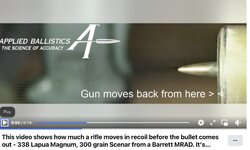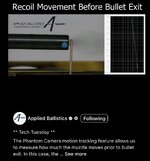Do you think this is caused by the shooter flinching due to recoil? Or caused by recoil affecting the bullet before it exits the barrel?
I am not one to say how well one person shoots their magnums and how well they can kill. Maybe they have the training or the mojo. Those people exist.
I am not one to say that everyone should sell their magnums and buy a .223. Shoot what you want.
Saying that everyone can shoot a lighter recoiling rifle better shouldn’t be controversial. It doesn’t mean any one person can’t shoot a magnum efficiently or effectively.
It doesn’t mean anything more than what it means. It seems to me that some shooters are offended by the idea.
Of course some shooters can shoot magnums just fine. But, there are probably many who are lying to themselves.
I mean, there is really no controversy in saying that women and children shoot smaller calibers better. Even though there are some that shoot magnums. Why would it be any different for men?
Back to the question, I think It’s both flinch and recoil generally, but with the well trained it’s gonna be rifle movement more than flinch. It’s one reason why any rifle, but especially magnums are easier to shoot the heavier the rifle, whether braked or suppressed.
But, as of today, I have never seen a shooter that can shoot their hunting magnums as good or better than a smaller caliber rifle in field positions on the clock or at long range.
I haven’t shot as many rounds as some, but of the thousands I have shot, I know that I can shoot my 6mm better than my 7mm. And, I killed stuff dead with my 7 just the same.
There is actually a way to think it through and understand the physical principles. The math kinda shows why a rifle only has to move an imperceptible amount to see an effect—like the width of a human hair (.002) before the bullet leaves the barrel.
One moa is 1.047 inch at 300 feet, and one moa at 1 foot is .003 inches. If a barrel moves a tiny bit, it matters.
It is widely held belief that “barrel harmonics” moves barrels, and that affect group size. If barrels are moving/bending before the bullet leaves, why can’t the whole rifle be moving as well.
According to the theory, barrel harmonics matter by maybe .5 inch at 100 yards. At the barrel that movement has to be around .003 if the barrel is two feet from the scope.
Rifle movement is dependent on overcoming momentum relative to the recoil impulse. The butt of a rifle is a little more than a foot from the chamber, where the movement originates, and about a couple feet from the center of gravity of most rifles.
In a quick field position, a magnum rifle has many avenues to exploit for that .003 or .006 amount of movement, because the position will not be perfect.
In addition to that, if the rifle is moving when the bullet leaves the barrel then that movement is added to the bullets trajectory. It’s like throwing a baseball from a moving car, the movement of the pitcher when the ball is released has to be factored in.
If it moves .0015, then it’s already .5 moa off, plus it has that movement of the barrel slinging the bullet which is going to add to it. It’s not nothing.
Ever wonder why so many long range magnum shots are “over the back”?


